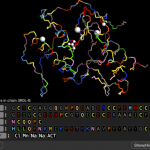active learning
Imagine a simple hike in a grassy part of South America. You hear a rattle and feel a quick stab of pain as fangs sink into your leg. Toxins in the snake venom travel through your blood vessels and penetrate your skin. If the snake is a South American rattlesnake, Crotalus terrific duressis, one of those toxins will be a phospholipase. Phospholipases attack cell and mitochondrial membranes destroying nerve and muscle function. Without quick treatment, a snakebite victim may be die or suffer permanent damage (1, 2).
The phospholipase from…
Physics is a notoriously difficult and unpopular subject, which is probably why there is a large and active Physics Education Research community within physics departments in the US. This normally generates a lot of material in the Physical Review Special Topics journal, but last week, a PER paper appeared in Science, which is unusual enough to deserve the ResearchBlogging treatment.
OK, what's this paper about? Well, with the exceptional originality that physicists bring to all things, the title pretty much says it all. They demonstrated that a different style of teaching applied to a large…
I re-watched Harry Potter and the Order of the Phoenix last night and my wife and I noticed something about teaching. Of course I mentioned that this would make a good blog post (and she may still post it on her blog, but I can't help myself). If you have not read the book or seen the movie, I don't think I will give away any serious spoilers - but who hasn't at least seen the movie? If you were going to see it (or read it) you would have done so by now - right?
The Order of the Phoenix shows at least three different examples of teachers and teachings in the movie. Here they are:
Dolores…
